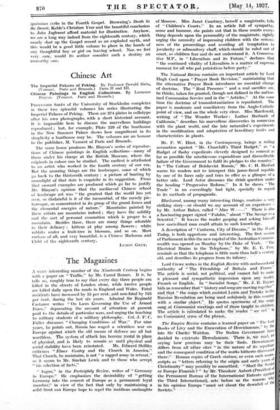Chinese Art
The Imperial Palaces of Peking. By Professor Oswald Siren; (Vanoest. Paris and Brussels.) Parts II and III.
Chinese Paintings in English Collections. By Laurence Binyon. (Vanoest. Paris and Brussels.) PROFESSOR &mix of the University of Stockholm completeS in these two splendid volumes his series illustrating the Imperial Palaces of Peking. There are 274 plates in collotype after his own photographs, with a short historical account. It is impossible here to discuss the marvellous buildings reproduced ; but, for example, Plate 229 of the boathouse in the New Summer Palace shows how magnificent in its simplicity a boathouse may be. The volumes are an honour to the publiSher, M. Vanoest of Paris and Brussels.
The same house produces Mr. Binyon's series of reproduc- tions of Chinese paintings in English collections—many of them under his charge at the British Museum, where the originals in colour can be studied. The earliest is attributed to an artist who worked in the fourth century of our era. But the amazing things are the landscapes, some of which to back to the thirteenth century ; a picture of boating by moonlight of that date is exquisite in its suggestion. From that onward examples are produced which go far to justify Mr. Binyon's opinion that the mediaeval Chinese school of landscape art was " the greatest that the world has yet seen, so disdainful is it of the inessential, of the merely pic- turesque, so concentrated in its grasp of the grand forms and the elemental energies of nature." Mountains painted by these artists are mountains indeed ; they have the solidity and the sort of personal emanation which is proper to a mountain. Besides these, -there are many things adorable in their delicacy : kittens at play among flowers ; white. rabbits under a fruit-tree in blossom, and so on. Most curious of all, and very beautiful, is a Chinese Madonna and Child of the eighteenth century.
LEMON GREY.


























































 Previous page
Previous page